The Notorious Bettie Page
Published on March 30th, 2011 in: Art, Back Off Man I'm A Feminist, DVD, Feminism, Issues, Movie Reviews, Movies, Teh Sex, Underground/Cult |Called “the greatest pinup model that ever lived” by pinup photographer Art Amsie, Bettie Page was nothing if not an enigma. The now-iconic images of her alternate between sweet, sassy cheesecake shots and those fetish photos and films that were brought before the Kefauver Hearings of the Senate Subcommittee on Juvenile Delinquency in the mid-1950s. It is this contrast and conflict that director Mary Harron examines in her 2005 film, The Notorious Bettie Page.

Gretchen Mol
as Bettie Page
The film skips around through Bettie’s life, beginning with the hearings in 1955, going back to her youth, then back and forth again throughout the 1940s and ’50s and finally forward to her departure from modeling and subsequent conversion to born again Christianity in 1957. These snapshots in time do not provide an exhaustive account of Bettie Page’s life but are not meant to. In some ways, the film provokes more questions than it answers, adding yet another chapter to the somewhat tantalizing mystery of Bettie Page herself.
Sensuality and sexuality are both addressed from the beginning of the film. Bettie, as played by Gretchen Mol, is shown waiting outside the courtroom during the Hearings; the camera pans up from Bettie’s feet, over her legs, and up her body to settle on her face. A police officer, either entranced by her beauty or amazed that Bettie Page, pinup model, is sitting before him, smiles at her awkwardly. Under a male director’s hand, this kind of camerawork might dominate the film, exploiting the character of Bettie instead of portraying her in a sympathetic light.
Yet Harron shows a sympathetic restraint. The darkest segments of the movie—sexual abuse and assault—are obvious but not explicit; such topics could never have been addressed or shown specifically in contemporaneous films. This, along with judicious use of stock footage and black and white film stock (as well as super-saturated Technicolor in some scenes), gives the film an authentic look and feel.
Mol portrays Bettie as friendly, trusting, open, and genuine. These traits, along with self-confidence and optimism, both endear her to the audience and propel her career as a pinup model. She has no shame in her body; former pinup model and aspiring photographer Bunny Yeager sees something special in Bettie’s candor and says that she’s “a true nudist,” one who doesn’t seem naked even without clothing.
Bettie views her career in bondage and fetish photos as just wearing “silly costumes,” defending the photographers and the clientele as very nice people. Siblings Irving and Paula Klaw are portrayed as decent and even wholesome. The fetish operation is shown as a moneymaking, although clandestine, sideline to their regular business selling movie star photos and film stills. Perhaps it is this forthright and family-oriented quality that ensures Bettie and the other models do not feel embarrassed over the images that the Hearings would eventually claim were guilty of “inciting lust and lascivious thoughts.”
Only when confronted by the disgust and prejudice of others does Bettie second-guess her path in life. One is naturally reminded of Adam and Eve, who were only aware and ashamed of their nakedness after being tempted by the Devil into eating from the Tree of Knowledge. Later in the film, Bettie responds to a question about her scandalous past by saying, “I’m not ashamed. Adam and Eve were naked in the Garden of Eden, weren’t they? When they sinned, they put on clothes.”

Bettie Page
Yet, her assurance is belied by her actions in both this fictionalized version of her life and her real one. In a 1998 interview with Playboy magazine, Page seems conflicted about her sexuality and her pinup career. She categorizes her sins as having “a lot of sex in my life” and thinking the Lord “disapproved of all those nude pictures of me,” even though earlier in the interview, she states “God approves of nudity.”
Further conflicts are revealed when Bettie describes journalist Richard Foster as a “monster” and “the devil posing as a human.” “He wants to make money, and he doesn’t care what he does to my reputation,” she continues. This is ostensibly in reference to revelations Foster made about Bettie’s mental illness, violence, arrests, and eventual institutionalization, none of which are addressed in Harron’s film as its world ends in 1957, another example of her obvious respect for her subject.
Yet, one wonders if Page, who refused to be photographed or filmed for later interviews, was just as nostalgic about her youth as those legions of fans who continue to idolize and emulate her look. “I want people to remember me as I was,” she says towards the end of the interview, and apologizes to those “who have been admirers of mine for years, [that they] have to read about my troubles.”
After the hearings, many of Bettie Page’s most notorious photos and films were destroyed, so that in many cases, only “inferior copies” remain. Yet neither time nor degraded image quality will diminish Bettie Page’s natural beauty or cast aspersions on the source of her glorious smile, one that is not only timeless but also far removed from the vacant pout of modern-day models. Although there was a darker side to the life of Bettie Page, it is not the one that people choose to remember, despite any and all attempts to the contrary.
Sources:
1. Wikipedia, “Bettie Page”
2. Kevin Cook, “My Story: The Missing Years.” Interview with Bettie Page. Playboy, January 1998.
3. The Official Site of Bettie Page, Biography section.
Time limit is exhausted. Please reload the CAPTCHA.